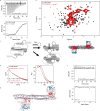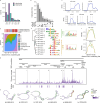The molecular dissection of TRIM25's RNA-binding mechanism provides key insights into its antiviral activity
- PMID: 39353916
- PMCID: PMC11445558
- DOI: 10.1038/s41467-024-52918-x
The molecular dissection of TRIM25's RNA-binding mechanism provides key insights into its antiviral activity
Abstract
TRIM25 is an RNA-binding ubiquitin E3 ligase with central but poorly understood roles in the innate immune response to RNA viruses. The link between TRIM25's RNA binding and its role in innate immunity has not been established. Thus, we utilized a multitude of biophysical techniques to identify key RNA-binding residues of TRIM25 and developed an RNA-binding deficient mutant (TRIM25-m9). Using iCLIP2 in virus-infected and uninfected cells, we identified TRIM25's RNA sequence and structure specificity, that it binds specifically to viral RNA, and that the interaction with RNA is critical for its antiviral activity.
© 2024. The Author(s).
Conflict of interest statement
The authors declare no competing interests.
Figures





Similar articles
-
Depressing time: Waiting, melancholia, and the psychoanalytic practice of care.In: Kirtsoglou E, Simpson B, editors. The Time of Anthropology: Studies of Contemporary Chronopolitics. Abingdon: Routledge; 2020. Chapter 5. In: Kirtsoglou E, Simpson B, editors. The Time of Anthropology: Studies of Contemporary Chronopolitics. Abingdon: Routledge; 2020. Chapter 5. PMID: 36137063 Free Books & Documents. Review.
-
TRIM25 predominately associates with anti-viral stress granules.Nat Commun. 2024 May 15;15(1):4127. doi: 10.1038/s41467-024-48596-4. Nat Commun. 2024. PMID: 38750080 Free PMC article.
-
Functional anatomy of zinc finger antiviral protein complexes.Nat Commun. 2024 Dec 30;15(1):10834. doi: 10.1038/s41467-024-55192-z. Nat Commun. 2024. PMID: 39738020 Free PMC article.
-
Unlocking data: Decision-maker perspectives on cross-sectoral data sharing and linkage as part of a whole-systems approach to public health policy and practice.Public Health Res (Southampt). 2024 Nov 20:1-30. doi: 10.3310/KYTW2173. Online ahead of print. Public Health Res (Southampt). 2024. PMID: 39582242
-
Antioxidants for female subfertility.Cochrane Database Syst Rev. 2017 Jul 28;7(7):CD007807. doi: 10.1002/14651858.CD007807.pub3. Cochrane Database Syst Rev. 2017. Update in: Cochrane Database Syst Rev. 2020 Aug 27;8:CD007807. doi: 10.1002/14651858.CD007807.pub4. PMID: 28752910 Free PMC article. Updated. Review.
References
MeSH terms
Substances
Grants and funding
- BB/T002751/1/RCUK | Biotechnology and Biological Sciences Research Council (BBSRC)
- MR/R021562/1/RCUK | Medical Research Council (MRC)
- n.a./Joachim Herz Stiftung (Joachim Herz Foundation)
- BB/M011224/1/RCUK | Biotechnology and Biological Sciences Research Council (BBSRC)
- HE7291/8-1/Deutsche Forschungsgemeinschaft (German Research Foundation)
- WT_/Wellcome Trust/United Kingdom
- MC_UU_00034/5/MRC_/Medical Research Council/United Kingdom
- CC2075/WT_/Wellcome Trust/United Kingdom
- HE7291/1-1/Deutsche Forschungsgemeinschaft (German Research Foundation)
- CC2075/ARC_/Arthritis Research UK/United Kingdom
- MC_UU_00034/2/RCUK | Medical Research Council (MRC)
- 51NF40-182880/Schweizerischer Nationalfonds zur Förderung der Wissenschaftlichen Forschung (Swiss National Science Foundation)
- 101001634/EC | EU Framework Programme for Research and Innovation H2020 | H2020 Priority Excellent Science | H2020 European Research Council (H2020 Excellent Science - European Research Council)
LinkOut - more resources
Full Text Sources

